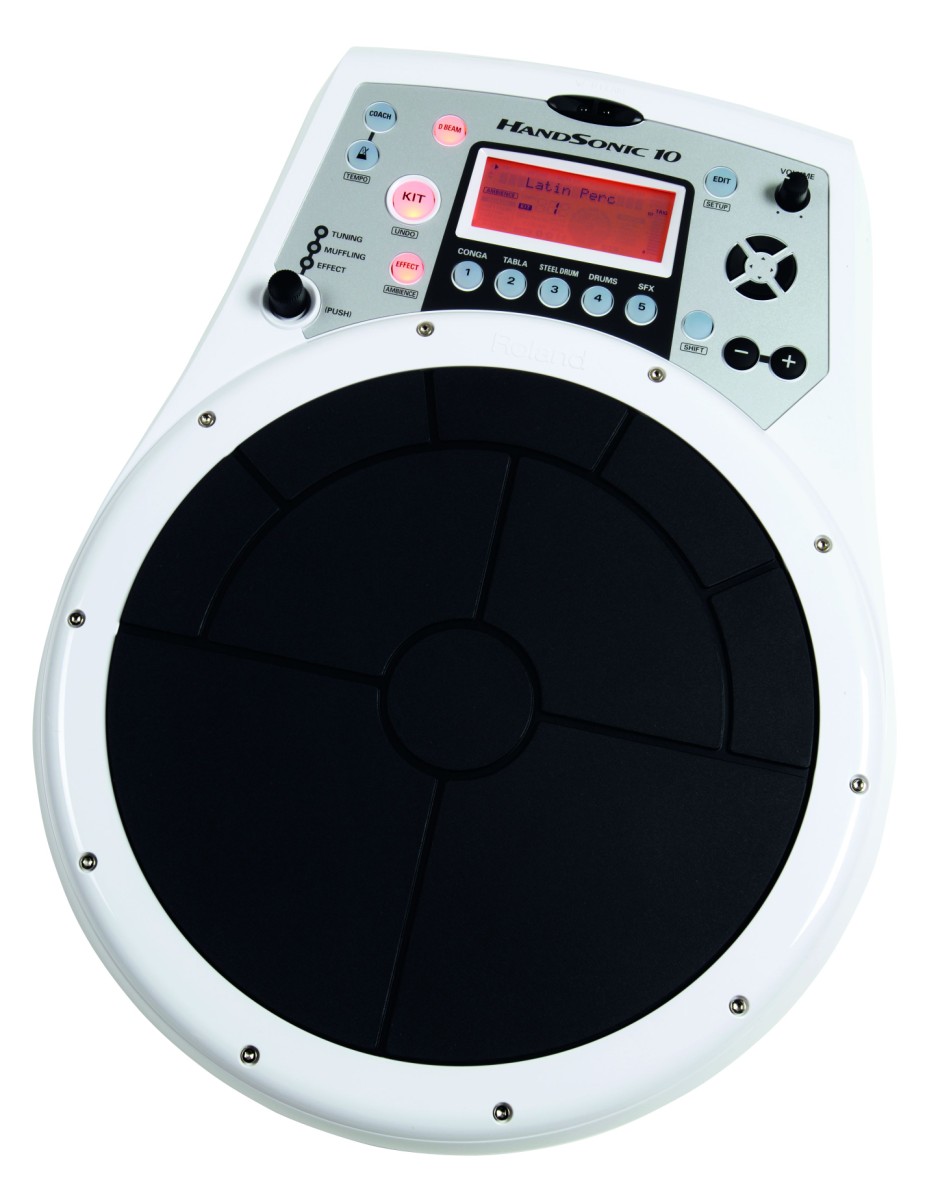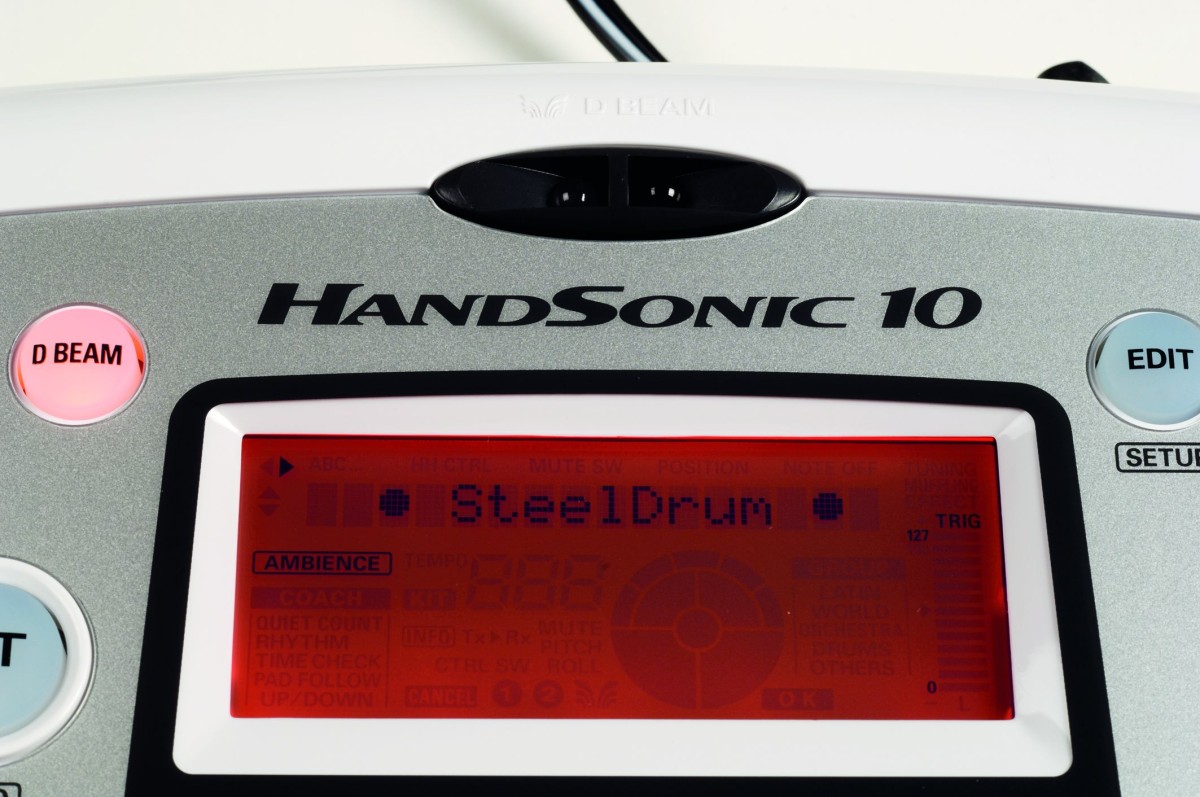MusicRadar Verdict
The HPD-10 is an extremely powerful creative weapon when used intelligently, and even when not, it's great fun, and the source of much inspiration. You have to hand it to Roland, this is yet another winner.
Pros
- +
Perfectly proportioned and professional. Fantastic range of on-board sounds.
Cons
- -
Playing 'standard' drum patterns on it can sometimes be tricky.
MusicRadar's got your back


Given that hand percussion represents the oldest form of musical expression known to man, the very existence of the Roland Handsonic range - a brace of finger-friendly electronic percussion devices - shows just how much things have progressed. Where early man had to settle for the visceral but somewhat limiting 'hand on hollow log' option, today's purveyor of percussive arts can access everything from tabla to triangle, acoustic snares to electro kicks in one handy, hand operated package.
They come no handier than the new HPD-10, the downsized sibling of Roland's flagship (and robustly popular) HPD-15 Handsonic. This unit might be more modestly proportioned but it's impressively specified and opens up avenues for any creative drummer.
No matter whether you generally use digits or sticks to shape your sound, the HPD-10 concept is worthy of further investigation.
Hands on deck
The HPD-15 is a pretty chunky unit and it's clear that, where the HPD-10 is concerned, Roland was keen to shave off some girth and deliver a more compact instrument. They've done a good job - the HPD-10 is perfectly proportioned. Measuring roughly 12" across, it's big enough to allow for a comfortable playing surface, but also fits snugly on your lap. It's remarkably tactile, positively encouraging a hands-on approach and forcing you to think differently about the way you create rhythms.
The rubber playing area is divided into 10 individual pads - the two largest take up most of the lower half of the surface while two smaller 'quarters' and four curved sections are found on the top with the final round pad located bang in the middle.
The rim of the HPD-10 clearly apes that of a conga, in as much as it is nicely rounded off, and this, coupled with the softness of the rubber pads, makes playing the HPD-10 a joy. Even for pampered hands.
Simplicity is at the heart of the new Handsonic, and the section of the unit not dominated by rubber is wonderfully easy to navigate without recourse to the manual. A well-sized orange backlit LCD screen carries information and underneath this is one of the HPD-10's masterstrokes. It comes in the form of five buttons, which are labelled Conga, Tabla, Steel Drum, Drums and SFX respectively.
In practice this means that whatever patch you are playing at any given moment, you can instantly switch to a palette of conga or steel drum sounds. It's a great feature and is a real boon in live performance situations.
No one-trick pony
On-stage operation is far from the unit's only bow string. As with all of Roland's current electronic drum output it also offers on-board rhythm coaching (thanks to the, er, Rhythm Coach section) and will fit neatly into a recording or programme studio.
With around 400 internal sounds to choose from, the HPD-10 makes for a very decent sound module in its own right, but its now-standard MIDI compatibility means it can also trigger external sources or be used to input beats direct into a PC or Mac sequencing package.
Which makes an awful lot of sense for those working in smaller areas without space for a V-Drum kit, but who hate playing in patterns on a keyboard. (That'll be all of us then, surely?) The now infamous Roland D-Beam also crops up on the HPD-10, allowing sounds to be triggered as if from thin air simply by passing a hand through the invisible beam at the very top of the casing. And no matter how many times you do it, it'll always make you smile.
It's still Jean Michel Jarre-ish after all these years - and of course it also means the instrument delivers an extra sound aside from those accessed by the pads.
Tone-tastic
Roland will doubtless be chuffed to learn that we consider it almost a given that its electronic drum gear is going to sound incredible these days. So, suffice it to say that, unsurprisingly, the HPD-10 is a real tonal heavyweight. There's a remarkable depth and richness to 'acoustic' sounds such as the djembes and cajons here, and a sense of 3D in the bass, snares and hi-hats contained in the drum kit patches.
In short, if there's anything that disappoints on the HPD-10, it won't be the way it sounds.
In fact, we found the most disappointing things about the unit were a) the harsh light that it threw on our feeble knowledge of conga and steel drum grooves and b) the frustration in not being able to play 'standard' drum patterns with the seriously impressive sounds herein on account of digital dysfunction.
It's just not easy to play hi-hat eighth notes and even the simplest bass drum pattern with one hand while playing snare with the other. We're not sure it can be done though - we've seen Steve Fisher (extremely capable Roland US drum demo guru) do some amazing things with one of these - but it's a whole new world to us...
All is not lost however, because if you do want to use the HPD-10 as a kind of super-small drum kit, you can add a kick trigger to take care of bass drum duties, or hook up a second pad for further options.
The biggest mistake drummers could make with the HPD-10 is to assume that it's for percussionists only. It's really not. Such is the breadth of its possible uses - studio tool, standalone instrument, add-on drum kit percussion module etc - that it deserves attention from the wider drumming community.
MusicRadar is the number 1 website for music makers of all kinds, be they guitarists, drummers, keyboard players, djs or producers...
GEAR: We help musicians find the best gear with top-ranking gear round-ups and high- quality, authoritative reviews by a wide team of highly experienced experts.
TIPS: We also provide tuition, from bite-sized tips to advanced work-outs and guidance from recognised musicians and stars.
STARS: We talk to musicians and stars about their creative processes, and the nuts and bolts of their gear and technique. We give fans an insight into the actual craft of music making that no other music website can.
“The most musical, unique and dynamic distortion effects I’ve ever used”: Linkin Park reveal the secret weapon behind their From Zero guitar tone – and it was designed by former Poison guitarist Blues Saraceno’s dad
Arturia’s V Collection gets a Roland JP-8000 emulation and lo-fi synth/sampler, along with five more instruments and a host of updates
Capture the sound of The Last of Us season 2's haunting soundtrack with Spitfire Audio’s latest software instrument, Ronroco by Gustavo Santaolalla










